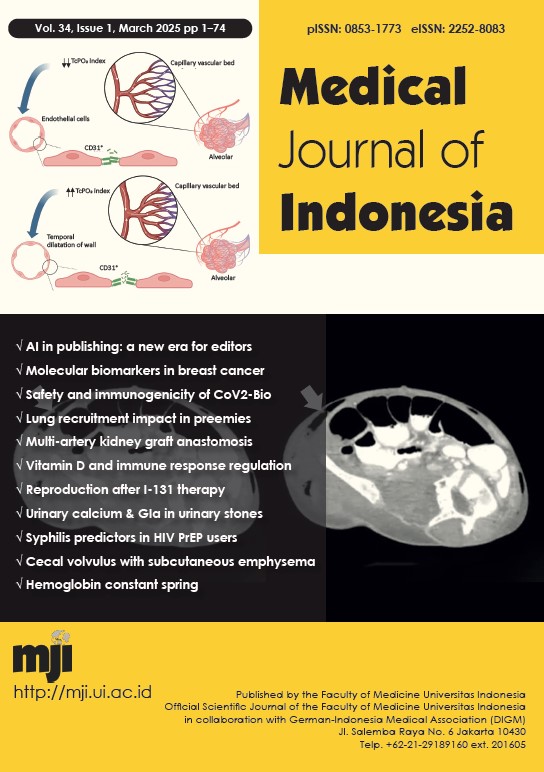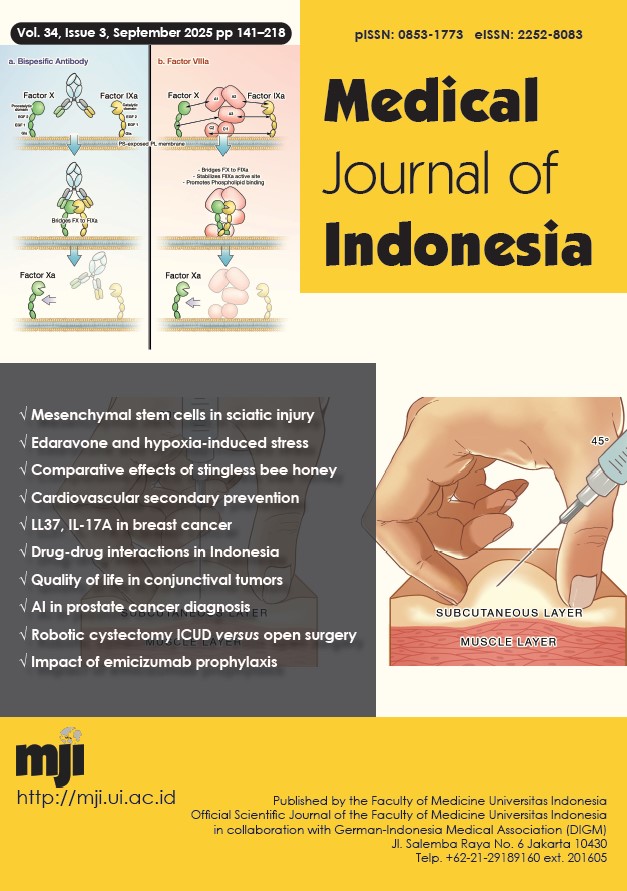Safety and immunogenicity of the CoV2-Bio in a healthy population aged 18 years and older in Indonesia
DOI:
https://doi.org/10.13181/mji.oa.247476Keywords:
CoronaVac, COVID-19 vaccine, protein subunit vaccineAbstract
BACKGROUND According to the WHO Target Product Profiles for COVID-19 Vaccines, vaccine development should be indicated for active immunization in all populations, in conjunction with other control measures to curtail the pandemic. Several RBD-based COVID-19 vaccines are being evaluated and have shown advantages. CoV2-Bio was developed based on the wild-type SARS-CoV-2 RBD amino acid sequence, representing residues of the spike protein of the Wuhan-Hu-1 isolate. This study aimed to evaluate the safety and immunogenicity of CoV2-Bio when compared to CoronaVac.
METHODS This was an observer-blinded, randomized controlled prospective study of safety and immunogenicity of the CoV2-Bio in healthy adult population. A total of 54 healthy participants were randomized to receive either 3 doses of CoV2-Bio or 2 doses of CoronaVac, and 1 dose of placebo, administered 28 days apart. Participants were followed up for safety and immunogenicity. IgG antibody titers (ELISA) and neutralization assay against Wuhan and Delta strains were evaluated at baseline, Days 28, 56, and 84. We assessed seropositive rate, seroconversion, and GMT as parameters.
RESULTS Both vaccines were well tolerated and induced good antibody response. The incidence rate and intensity of local and systemic adverse events did not differ between vaccine and control groups. The vaccine group showed a larger proportion of seroconversion (4-fold increase antibody) (87.5% versus 46.2%, p = 0.001) and higher GMT (305.9 AU/ml versus 102.4 AU/ml, p<0.001) when compared to control group.
CONCLUSIONS 3 doses of the CoV2-Bio are safe and immunogenic in healthy adult population. 3 doses of the CoV2-Bio COVID-19 vaccine produce a better immunogenicity profile compared to CoronaVac.
Downloads
References
Hotez PJ, Bottazzi ME. Developing a low-cost and accessible COVID-19 vaccine for global health. PLoS Negl Trop Dis. 2020;14(7):e0008548. https://doi.org/10.1371/journal.pntd.0008548
Dong Y, Dai T, Wei Y, Zhang L, Zheng M, Zhou F. A systematic review of SARS-CoV-2 vaccine candidates. Signal Transduct Target Ther. 2020;5(1):237. https://doi.org/10.1038/s41392-020-00352-y
To KK, Tsang OT, Leung WS, Tam AR, Wu TC, Lung DC, et al. Temporal profiles of viral load in posterior oropharyngeal saliva samples and serum antibody responses during infection by SARS-CoV-2: an observational cohort study. Lancet Infect Dis. 2020;20(5):565−74. https://doi.org/10.1016/S1473-3099(20)30196-1
Yan R, Zhang Y, Li Y, Xia L, Guo Y, Zhou Q. Structural basis for the recognition of SARS-CoV-2 by full-length human ACE2. Science. 2020;367(6485):1444−8. https://doi.org/10.1126/science.abb2762
Cai Y, Zhang J, Xiao T, Peng H, Sterling SM, Walsh RM Jr, et al. Distinct conformational states of SARS-CoV-2 spike protein. Science. 2020;369(6511):1586−92. https://doi.org/10.1126/science.abd4251
Dai L, Gao GF. Viral targets for vaccines against COVID-19. Nat Rev Immunol. 2021;21(2):73−82. https://doi.org/10.1038/s41577-020-00480-0
Pormohammad A, Zarei M, Ghorbani S, Mohammadi M, Razizadeh MH, Turner DL, et al. Efficacy and safety of COVID-19 vaccines: a systematic review and meta-analysis of randomized clinical trials. Vaccines (Basel). 2021;9(5):467. https://doi.org/10.3390/vaccines9050467
Karbalaei M, Rezaee SA, Farsiani H. Pichia pastoris: a highly successful expression system for optimal synthesis of heterologous proteins. J Cell Physiol. 2020;235(9):5867−81. https://doi.org/10.1002/jcp.29583
Kumar R, Kumar P. Yeast-based vaccines:n perspective in vaccine development and application. FEMS Yeast Res. 2019;19(2):foz007. https://doi.org/10.1093/femsyr/foz007
Kleanthous H, Silverman JM, Makar KW, Yoon IK, Jackson N, Vaughn DW. Scientific rationale for developing potent RBD-based vaccines targeting COVID-19. NPJ Vaccines. 2021;6(1):128. https://doi.org/10.1038/s41541-021-00393-6
Shah RR, Hassett KJ, Brito LA. Overview of vaccine adjuvants: introduction, history, and current status. Methods Mol Biol. 2017;1494:1−13. https://doi.org/10.1007/978-1-4939-6445-1_1
Yang S, Li Y, Dai L, Wang J, He P, Li C, et al. Safety and immunogenicity of a recombinant tandem-repeat dimeric RBD-based protein subunit vaccine (ZF2001) against COVID-19 in adults: two randomised, double-blind, placebo-controlled, phase 1 and 2 trials. Lancet Infect Dis. 2021;21(8):1107−19. https://doi.org/10.1016/S1473-3099(21)00127-4
Hernández-Bernal F, Ricardo-Cobas MC, Martín-Bauta Y, Navarro-Rodríguez Z, Piñera-Martínez M, Quintana-Guerra J, et al. Safety, tolerability, and immunogenicity of a SARS-CoV-2 recombinant spike RBD protein vaccine: a randomised, double-blind, placebo-controlled, phase 1-2 clinical trial (ABDALA Study). EClinicalMedicine. 2022;46:101383. https://doi.org/10.1016/j.eclinm.2022.101383
Dai L, Gao L, Tao L, Hadinegoro SR, Erkin M, Ying Z, et al. Efficacy and safety of the RBD-dimer-based Covid-19 vaccine ZF2001 in adults. N Engl J Med. 2022;386(22):2097−111. https://doi.org/10.1056/NEJMoa2202261
Hernández-Bernal F, Ricardo-Cobas MC, Martín-Bauta Y, Rodríguez-Martínez E, Urrutia-Pérez K, Urrutia-Pérez K, et al. A phase 3, randomised, double-blind, placebo-controlled clinical trial evaluation of the efficacy and safety of a SARS-CoV-2 recombinant spike RBD protein vaccine in adults (ABDALA-3 study). Lancet Reg Health Am. 2023;21:100497. https://doi.org/10.1016/j.lana.2023.100497
Thuluva S, Paradkar V, Gunneri SR, Yerroju V, Mogulla R, Turaga K, et al. Evaluation of safety and immunogenicity of receptor binding domain-based COVID-19 vaccine (Corbevax) to select the optimum formulation in open-label, multicentre, and randomised phase-1/2 and phase-2 clinical trials. EBioMedicine. 2022;83:104217. https://doi.org/10.1016/j.ebiom.2022.104217
Heath PT, Galiza EP, Baxter DN, Boffito M, Browne D, Burns F, et al. Safety and efficacy of the NVX-CoV2373 coronavirus disease 2019 vaccine at completion of the placebo-controlled phase of a randomized controlled trial. Clin Infect Dis. 2023;76(3):398−407. https://doi.org/10.1093/cid/ciac803
Nurdin A, Movieta Nency Y, Maddeppungeng M, Sekartini R, Mulia Sari R, Surachman F, et al. Immunogenicity and safety of SARS-CoV-2 recombinant protein subunit vaccine (IndoVac) adjuvanted with alum and CpG 1018 in Indonesian adults: a phase 3, randomized, active-controlled, multicenter trial. Vaccine. 2024;42(12):3009−17. https://doi.org/10.1016/j.vaccine.2024.03.077
Wu Z, Hu Y, Xu M, Chen Z, Yang W, Jiang Z, et al. Safety, tolerability, and immunogenicity of an inactivated SARS-CoV-2 vaccine (CoronaVac) in healthy adults aged 60 years and older: a randomised, double-blind, placebo-controlled, phase 1/2 clinical trial. Lancet Infect Dis. 2021;21(6):803−12. https://doi.org/10.1016/S1473-3099(20)30987-7
Ramasamy MN, Minassian AM, Ewer KJ, Flaxman AL, Folegatti PM, Owens DR, et al. Safety and immunogenicity of ChAdOx1 nCoV-19 vaccine administered in a prime-boost regimen in young and old adults (COV002): a single-blind, randomised, controlled, phase 2/3 trial. Lancet. 2021;396(10267):1979−93. Erratum in: Lancet. 2021;396(10267):1978. Erratum in: Lancet. 2021;397(10282):1350. https://doi.org/10.1016/S0140-6736(20)32466-1
Zhu FC, Guan XH, Li YH, Huang JY, Jiang T, Hou LH, et al. Immunogenicity and safety of a recombinant adenovirus type-5-vectored COVID-19 vaccine in healthy adults aged 18 years or older: a randomised, double-blind, placebo-controlled, phase 2 trial. Lancet. 2020;396(10249):479−88. https://doi.org/10.1016/S0140-6736(20)31605-6
Anderson EJ, Rouphael NG, Widge AT, Jackson LA, Roberts PC, Makhene M, et al. Safety and Immunogenicity of SARS-CoV-2 mRNA-1273 vaccine in older adults. N Engl J Med. 2020;383(25):2427−38. https://doi.org/10.1056/NEJMoa2028436
Harimurti K, Jasmin H, Sekartini R, Aini M, Yuniar I, Indawati W, et al. Evaluation of safety and anti-RBD IgG Sars Cov-2 after Indovac administration in Depok. EJournal Kedokteran Indonesia. 2023;11(2):118−25. https://doi.org/10.23886/ejki.11.393.118-25
Dimmitt S, Stampfer H, Martin JH. When less is more - efficacy with less toxicity at the ED50. Br J Clin Pharmacol. 2017;83(7):1365−8. https://doi.org/10.1111/bcp.13281
Moss P. The T cell immune response against SARS-CoV-2. Nat Immunol. 2022;23:186-93. https://doi.org/10.1038/s41590-021-01122-w
Published
How to Cite
Issue
Section
License
Copyright (c) 2025 Suzy Maria, Ciho Olfriani, Sukamto Koesnoe, Rini Sekartini, Soedjatmiko, Bernie Endyarni Medise, Irene Yuniar, Wahyuni Indawati, Angga Wirahmadi, Rini Mulia Sari, Nuri Purwito Adi, Windri Retnaningdyah

This work is licensed under a Creative Commons Attribution-NonCommercial 4.0 International License.
Authors who publish with Medical Journal of Indonesia agree to the following terms:
- Authors retain copyright and grant Medical Journal of Indonesia right of first publication with the work simultaneously licensed under a Creative Commons Attribution-NonCommercial License that allows others to remix, adapt, build upon the work non-commercially with an acknowledgment of the work’s authorship and initial publication in Medical Journal of Indonesia.
- Authors are permitted to copy and redistribute the journal's published version of the work non-commercially (e.g., post it to an institutional repository or publish it in a book), with an acknowledgment of its initial publication in Medical Journal of Indonesia.






































